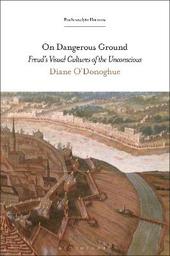
|
On Dangerous Ground: Freud's Visual Cultures of the Unconscious
Paperback / softback
Main Details
| Title |
On Dangerous Ground: Freud's Visual Cultures of the Unconscious
|
| Authors and Contributors |
By (author) Dr. Diane O'Donoghue
|
| Series | Psychoanalytic Horizons |
|---|
| Physical Properties |
| Format:Paperback / softback | | Pages:400 | | Dimensions(mm): Height 216,Width 140 |
|
| Category/Genre | Theory of art
Literary theory |
|---|
| ISBN/Barcode |
9781501363047
|
| Classifications | Dewey:150.1952092 |
|---|
| Audience | | Tertiary Education (US: College) | |
|---|
| Illustrations |
40 bw illus
|
|
Publishing Details |
| Publisher |
Bloomsbury Publishing Plc
|
| Imprint |
Bloomsbury Academic USA
|
| Publication Date |
30 April 2020 |
| Publication Country |
United States
|
Description
Winner of the 2019 Robert S. Liebert Award (established jointly by the Association for Psychoanalytic Medicine and the Columbia University Center for Psychoanalytic Training and Research) In the final years of the 19th century, Sigmund Freud began to construct evidence for the workings of an "unconscious." On Dangerous Ground offers an innovative assessment of the complex role that his encounters with visual cultures-architecture, objects from earlier cultural epochs ("antiquities"), paintings, and illustrated books-played in that process. Diane O'Donoghue introduces, often using unpublished archival sources, the ways in which material phenomena profoundly informed Freud's decisions about what would, and would not, constitute the workings of an inner life. By returning to view content that Freud treated as forgettable, as distinct from repressed, O'Donoghue shows us a realm of experiences that Freud wished to remove from psychical meaning. These erasures form an amnesic core within Freud's psychoanalytic project, an absence that includes difficult aspects of his life narrative, beginning with the dislocations of his early childhood that he declared "not worth remembering." What is made visible here is far from the inconsequential surface of experience; rather, we are shown a dangerous ground that exceeds the limits of what Freud wished to include within his early model of mind. In Freud's relation to visual cultures we find clues to what he attempted, in crafting his unconscious, to remove from sight.
Author Biography
Diane O'Donoghue is Director of the Program for Public Humanities and Senior Fellow for the Humanities at the Jonathan M. Tisch College for Civic Life, at Tufts University, USA. She is also Visiting Professor for Public Humanities at Brown University, and a scholar member of and on the faculty at the Boston Psychoanalytic Society and Institute. There she has been a Silberger Scholar and is a recipient of their Felix and Helene Deutsch Prize. Her work on Freud's early formulations of psychoanalysis also has been awarded the CORST Prize from the American Psychoanalytic Association.
ReviewsDiane O'Donoghue's On Dangerous Ground: Freud's Visual Cultures of the Unconscious is an original contribution to the study of psychoanalysis and our visual world. The wide range of images from Freud's world shows us how wide and deep his visual world impacted on his writing and thinking. Focussing on Freud's emphasis on visualization as a core element of the unconscious, O'Donoghue's work actually illustrates how each and every one of us incorporates our visual context, real or virtual, into the articulation of our desires. We are in complex ways what we see and thus how we dream and how we imagine ourselves. A strong, readable and compelling book! * Sander L. Gilman, Distinguished Professor of Liberal Arts and Sciences and Professor of Psychiatry, Emory University, USA * In this startlingly brilliant, original and deeply researched book, Diane O'Donoghue presents an entirely new way of understanding Freud--indeed, of writing intellectual history. She examines examples of art and architecture in Freud's life and links his complex aesthetic responses and insights to his developing psychoanalytic theory. This remarkable book is a landmark and an absolutely indispensable understanding of Freud. * Susannah Heschel, Eli Black Professor of Jewish Studies, Dartmouth College, USA * This is a bold and imaginative exploration of the interplay not just between visual culture and Freudian psychoanalysis, but of Freud's personal Dingwelt and its role the complex genesis of his theorization of the unconscious. In a field as trampled as Freudian biography, O'Donoghue has managed to take a refreshingly different approach that argues for a whole new way of thinking with, through, and about things-from whole buildings and railway lines to specific books and tiny artifacts. She arrives at a new vision of how Freud's thinking about the unconscious converges around experiences, places, and objects that threaded through his life's trajectory. This is a deep dive into some of the most essential questions surrounding Freud's creation of psychoanalysis, and rewards the reader throughout with ways of reframing Freud's life and writings. Fruit of a long labor of preparation, this is a work of committed and critical scholarship, and merits careful consideration. * Richard H. Armstrong, Associate Professor of Classical Studies, University of Houston, USA, and author of A Compulsion for Antiquity: Freud and the Ancient World (2006) *
|